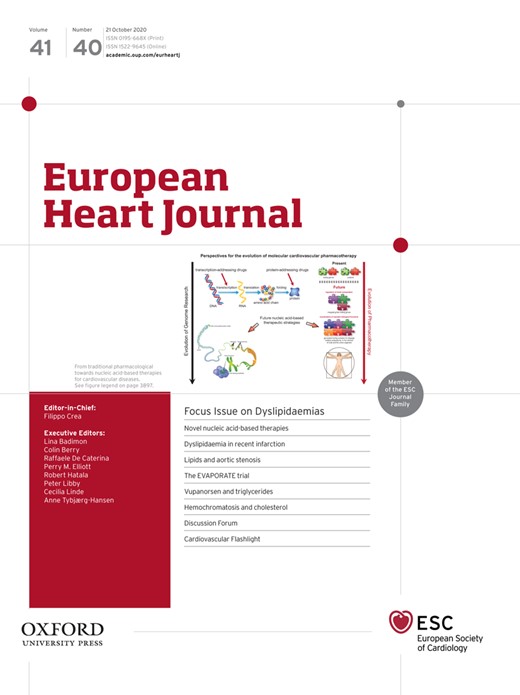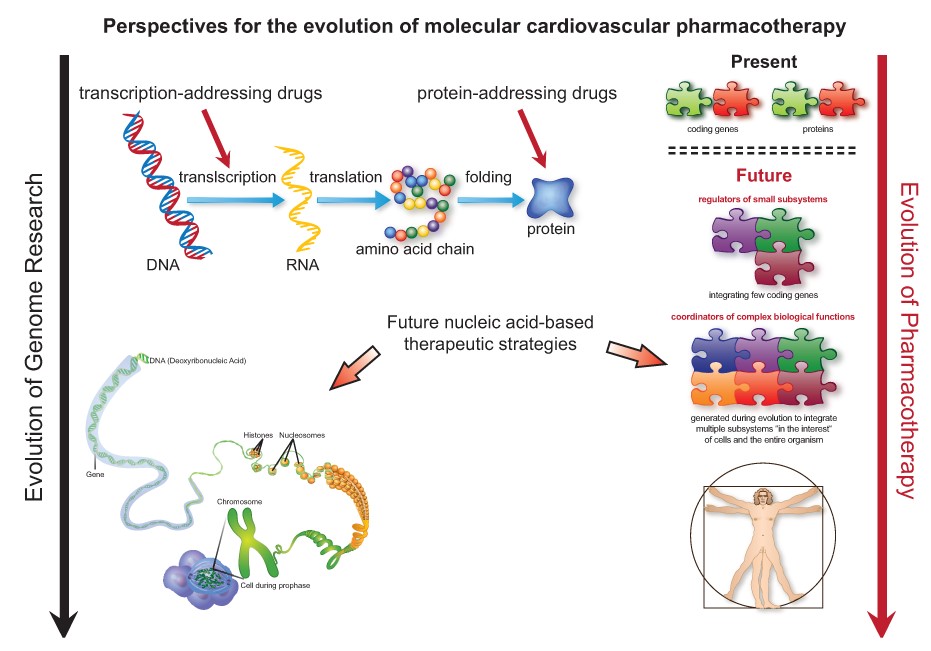
Volume 41, Issue 40
21 October 2020
Cover image

Cover image

From traditional pharmacological towards nucleic acid-based therapies for cardiovascular diseases
Ulf Landmesser 1,2,3,*†,Wolfgang Poller 1,2,*†, Sotirios Tsimikas 4, Patrick Most 5,6,7,
Francesco Paneni 8,9,10, and Thomas F. Lüscher 8,11
1 Department of Cardiology, Campus Benjamin Franklin, CC11 (Cardiovascular Medicine), Charite—Universitätsmedizin Berlin, Hindenburgdamm 30, 12203 Berlin, Germany; 2 German Center for Cardiovascular Research (DZHK), Partner Site Berlin, Berlin, Germany; 3 Berlin Institute of Health, Anna-Louisa-Karsch-Strasse 2, 10178 Berlin, Germany; 4 Division of Cardiovascular Medicine, Sulpizio Cardiovascular Center, University of California San Diego, 9500 Gilman Drive, BSB 1080, La Jolla, CA 92093-0682, USA; 5 German Center for Cardiovascular Research (DZHK), Partner Site Heidelberg/Mannheim, University of Heidelberg, Heidelberg, Germany;
6 Center for Translational Medicine, Jefferson Medical College, 1020 Locust Street, Philadelphia, PA 19107, USA; 7 Molecular and Translational Cardiology, Department of Medicine III, Heidelberg University Hospital, Im Neuenheimer Feld 669, 69120 Heidelberg, Germany; 8 Center for Molecular Cardiology, University of Zürich, Wagistrasse 12, 8952 Schlieren, Switzerland; 9 Department of Cardiology, University Heart Center, University Hospital Zurich, Rämistrasse 100, 8091 Zurich, Switzerland; 10 Department of Research and Education, University Hospital Zurich, Rämistrasse 100, MOU2, 8091 Zurich, Switzerland; 11 Research, Education and Development, Royal Brompton and Harefield Hospital Trust and Imperial College London, National Heart and Lung Institute, Guy Scadding Building, Dovehouse Street, London SW3 6LY, UK
Ulf Landmesser and Wolfgang Poller contributed equally to the study.
Corresponding authors. Tel: +49-30-450-513702, Email: [email protected] (U.L.); Tel: +49-30-450-513765, Email: [email protected] (W.P.)
Nucleic acid-based therapeutics are currently developed at large scale for prevention and management of cardiovascular diseases (CVDs), since: (i) genetic studies have highlighted novel therapeutic targets suggested to be causal for CVD; (ii) there is a substantial recent progress in delivery, efficacy, and safety of nucleic acid-based therapies; (iii) they enable effective modulation of therapeutic targets that cannot be sufficiently or optimally addressed using traditional small molecule drugs or antibodies. Nucleic acid-based therapeutics include (i) RNA-targeted therapeutics for gene silencing; (ii) microRNA-modulating and epigenetic therapies; (iii) gene therapies; and (iv) genome-editing approaches (e.g. CRISPR-Cas-based):
(i) RNA-targeted therapeutics: several large-scale clinical development programmes, using antisense oligonucleotides (ASO) or short interfering RNA (siRNA) therapeutics for prevention and management of CVD have been initiated. These include ASO and/or siRNA molecules to lower apolipoprotein (a) [apo(a)], proprotein convertase subtilisin/kexin type 9 (PCSK9), apoCIII, ANGPTL3, or transthyretin (TTR) for prevention and treatment of patients with atherosclerotic CVD or TTR amyloidosis.
(ii) MicroRNA-modulating and epigenetic therapies: novel potential therapeutic targets are continually arising from human non-coding genome and epigenetic research. First microRNA-based therapeutics or therapies targeting epigenetic regulatory pathways are in clinical studies.
(iii) Gene therapies: EMA/FDA have approved gene therapies for non-cardiac monogenic diseases and LDL receptor gene therapy is currently being examined in patients with homozygous hypercholesterolaemia. In experimental studies, gene therapy has significantly improved cardiac function in heart failure animal models.
(iv) Genome editing approaches: these technologies, such as using CRISPR-Cas, have proven powerful in stem cells, however, important challenges are remaining, e.g. low rates of homology-directed repair in somatic cells such as cardiomyocytes. In summary, RNA-targeted therapies (e.g. apo(a)-ASO and PCSK9-siRNA) are now in large-scale clinical outcome trials and will most likely become a novel effective and safe therapeutic option for CVD in the near future. MicroRNA-modulating, epigenetic, and gene therapies are tested in early clinical studies for CVD. CRISPR-Cas-mediated genome editing is highly effective in stem cells, but major challenges are remaining in somatic cells, however, this field is rapidly advancing.
Cardiovascular diseases • Nucleic acid therapeutics • Non-coding genome • Epigenome • RNA interference • Antisense • CRISPR
Figure 9 Perspectives for the evolution of molecular cardiovascular therapies. System integration in engineering is the process of bringing together the component sub-systems into one system (an aggregation of subsystems cooperating so that the system is able to deliver the overarching functionality) and ensuring that the subsystems function together as a whole. System integration in information technology means the process of linking together different computing systems and software applications physically or functionally, to act as a co-ordinated whole. System integration in human molecular biology accordingly means the linking together of the component sub-systems of the human genome into one system able to deliver the overarching functionality at the cellular level which already is a huge challenge. However, beyond the complexity of non-biological systems in engineering and information technology, overall ‘healthy’ system integration in humans requires critical further levels of co-ordination since multiple types of cells with entirely different tasks and internal regulation need to work together to maintain proper structure and function of the entire organism. The ultimate challenge is to ensure this under ‘normal’ baseline conditions and also under conditions of pathogenic stress. One may safely assume that the challenge to survive put critical evolutionary selection pressure for any ‘genomic integrator’ capable to improve integration of the sub-systems of higher organisms. Recent basic and clinical research suggests the existence of hitherto unrecognized ‘master regulators’ at the epigenome and non-coding genome level, and these targets may prove useful as a new type of therapeutic targets.
ISSN 0195-668X
EISSN 1522-9645
Issue navigation
Volume 41, Issue 40, 21 October 2020
Focus Issue on Dyslipidaemias
Issue @ A Glance
Dyslipidaemias and cardiovascular diseases: beyond cholesterol and atherosclerotic plaques
Filippo Crea
European Heart Journal, Volume 41, Issue 40, 21 October 2020, Pages 3865–3869, https://doi.org/10.1093/eurheartj/ehaa889
CardioPulse
The new Dyslipidaemia Team of the European Heart Journal
European Heart Journal, Volume 41, Issue 40, 21 October 2020, Pages 3870–3871, https://doi.org/10.1093/eurheartj/ehaa680
The European Heart Journal – Digital Health
Nico Bruining
European Heart Journal, Volume 41, Issue 40, 21 October 2020, Pages 3871–3872, https://doi.org/10.1093/eurheartj/ehaa838
ESC Congress 2020 - Young Investigator Awards
Mark Nicholls
European Heart Journal, Volume 41, Issue 40, 21 October 2020, Pages 3873–3874, https://doi.org/10.1093/eurheartj/ehaa787
COVID-19 pandemic in India
Venkata S Ram and others
European Heart Journal, Volume 41, Issue 40, 21 October 2020, Pages 3874–3876, https://doi.org/10.1093/eurheartj/ehaa493
Czech Republic and low COVID-19 mortality in the heart of Europe: possible explanations
Petr Widimsky and others
European Heart Journal, Volume 41, Issue 40, 21 October 2020, Pages 3876–3879, https://doi.org/10.1093/eurheartj/ehaa465
Weekly Journal Scan
Low-dose colchicine: a new tool in the treatment of chronic coronary disease? Comment on the low-dose colchicine (LoDoCo)2 trial
Giovanna Liuzzo and Carlo Patrono
European Heart Journal, Volume 41, Issue 40, 21 October 2020, Pages 3880–3881, https://doi.org/10.1093/eurheartj/ehaa782
EMPEROR-Reduced supports the use of SGLT2 inhibitors for the treatment of patients with heart failure and reduced ejection fraction: Comment on the EMPEROR-Reduced trial
Giovanna Liuzzo and Carlo Patrono
European Heart Journal, Volume 41, Issue 40, 21 October 2020, Pages 3881–3882, https://doi.org/10.1093/eurheartj/ehaa783
Low-Dose Edoxaban for Stroke Prevention in Elderly Patients with Atrial Fibrillation: Comment on the Edoxaban Low-Dose for Elder Care Atrial Fibrillation Patients (ELDERCARE-AF) Trial
Giovanna Liuzzo and Carlo Patrono
European Heart Journal, Volume 41, Issue 40, 21 October 2020, Pages 3882–3883, https://doi.org/10.1093/eurheartj/ehaa836
State of the Art Review
From traditional pharmacological towards nucleic acid-based therapies for cardiovascular diseases
Ulf Landmesser and others
European Heart Journal, Volume 41, Issue 40, 21 October 2020, Pages 3884–3899, https://doi.org/10.1093/eurheartj/ehaa229
Clinical Research
Dyslipidaemias
Application of the 2019 ESC/EAS dyslipidaemia guidelines to nationwide data of patients with a recent myocardial infarction: a simulation study
Ali Allahyari and others
European Heart Journal, Volume 41, Issue 40, 21 October 2020, Pages 3900–3909, https://doi.org/10.1093/eurheartj/ehaa034
Editorial
Real-world data, theoretical application of guidelines, cost, and access: how do we optimize non-statin therapy for LDL-C/non-HDL-C/ApoB?
Christie M Ballantyne and Salim S Virani
European Heart Journal, Volume 41, Issue 40, 21 October 2020, Pages 3910–3912, https://doi.org/10.1093/eurheartj/ehaa139
Dyslipidaemias
Plasma lipids and risk of aortic valve stenosis: a Mendelian randomization study
Milad Nazarzadeh and others
European Heart Journal, Volume 41, Issue 40, 21 October 2020, Pages 3913–3920, https://doi.org/10.1093/eurheartj/ehaa070
Editorial
Lipid levels linked to symptomatic aortic valve stenosis: evidence from Mendelian randomization?
Christoph A Nienaber and Xun Yuan
European Heart Journal, Volume 41, Issue 40, 21 October 2020, Pages 3921–3924, https://doi.org/10.1093/eurheartj/ehaa225
Fast Track Congress
Dyslipidaemias
Effect of icosapent ethyl on progression of coronary atherosclerosis in patients with elevated triglycerides on statin therapy: final results of the EVAPORATE trial
Matthew J Budoff and others
European Heart Journal, Volume 41, Issue 40, 21 October 2020, Pages 3925–3932, https://doi.org/10.1093/eurheartj/ehaa652
Editorial
Can EPA evaporate plaques?
Lale Tokgozoglu and Alberico L Catapano
European Heart Journal, Volume 41, Issue 40, 21 October 2020, Pages 3933–3935, https://doi.org/10.1093/eurheartj/ehaa750
Dyslipidaemias
Vupanorsen, an N-acetyl galactosamine-conjugated antisense drug to ANGPTL3 mRNA, lowers triglycerides and atherogenic lipoproteins in patients with diabetes, hepatic steatosis, and hypertriglyceridaemia
Daniel Gaudet and others
European Heart Journal, Volume 41, Issue 40, 21 October 2020, Pages 3936–3945, https://doi.org/10.1093/eurheartj/ehaa689
Editorial
Advancing RNA-targeted therapy for personalised prevention of coronary disease: focus on ANGPLT3
Ulf Landmesser and Thomas F Lüscher
European Heart Journal, Volume 41, Issue 40, 21 October 2020, Pages 3946–3948, https://doi.org/10.1093/eurheartj/ehaa790
Translational Research
Dyslipidaemias
The haemochromatosis gene Hfe and Kupffer cells control LDL cholesterol homeostasis and impact on atherosclerosis development
Egon Demetz and others
European Heart Journal, Volume 41, Issue 40, 21 October 2020, Pages 3949–3959, https://doi.org/10.1093/eurheartj/ehaa140
Editorial
Role of homeostatic iron regulator protein in hepatic cholesterol metabolism: interaction between Kupffer cells and hepatocytes?
Lisanne L Blauw and Patrick C N Rensen
European Heart Journal, Volume 41, Issue 40, 21 October 2020, Pages 3960–3962, https://doi.org/10.1093/eurheartj/ehaa178
Discussion Forum
Life course explains the ‘obesity paradox’?
Timo E Strandberg and Arto Y Strandberg
European Heart Journal, Volume 41, Issue 40, 21 October 2020, Pages 3963–3964, https://doi.org/10.1093/eurheartj/ehaa717
The obesity paradigm in cardiovascular disease: the need for differentiated weight management
Wolfram Doehner and others
European Heart Journal, Volume 41, Issue 40, 21 October 2020, Page 3965, https://doi.org/10.1093/eurheartj/ehaa724
Cardiovascular Flashlight
Percutaneous closure of right coronary artery to the left ventricle coronary cameral fistula in a case of congenitally absent left coronary artery
Viji Samuel Thomson and others
European Heart Journal, Volume 41, Issue 40, 21 October 2020, Pages 3966–3967, https://doi.org/10.1093/eurheartj/ehaa364
Erratum
Erratum to: The PROFID project
European Heart Journal, Volume 41, Issue 40, 21 October 2020, Page 3948, https://doi.org/10.1093/eurheartj/ehaa876
Advertisement intended for healthcare professionals
Advertisement intended for healthcare professionals







